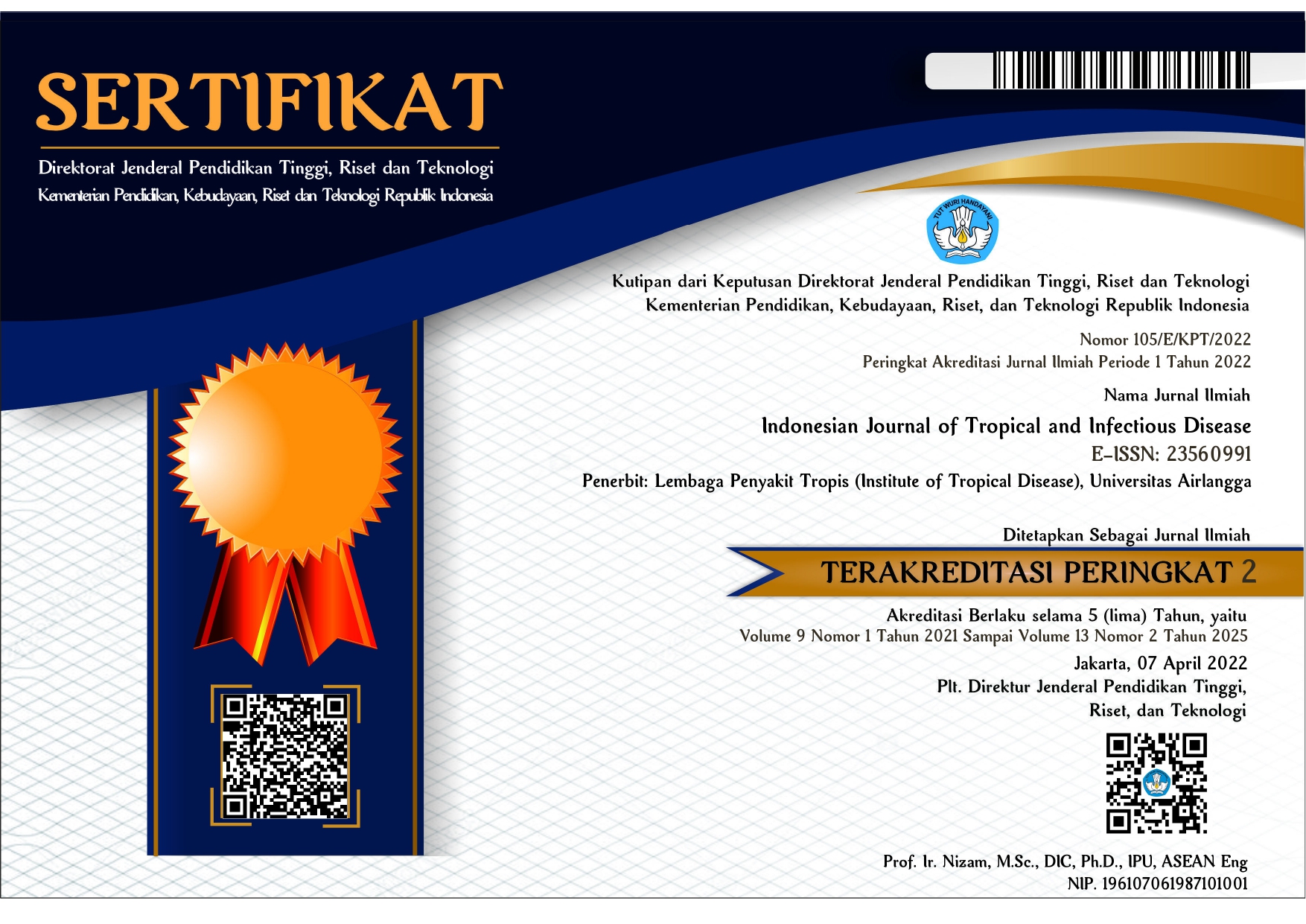DIFFERENCES OF UNIVERSAL AND MULTIPLEX PRIMER FOR DETECTION OF DENGUE VIRUS FROM PATIENTS SUSPECTED DENGUE HEMORRHAGIC FEVER (DHF) IN SURABAYA
Downloads
Dengue Hemorrhagic Fever (DHF) is a global health problem in tropical and subtropical regions, as well as endemic in110 countries around the world. Indonesia is one of the largest countries in the region of endemic dengue. In Indonesia, dengue virus infection has become a contagious disease that was very important and was reported in 1968. Many molecular epidemiological approaches have been developed to look for factor that has been assumed as the cause of the increase of prevalence dengue virus infection in the world. The aim of this study is for the detection and determination of serotype of dengue virus in Surabaya. The method used was the technique of Reverse Transcription-Polymerase Chain Reaction (RT-PCR) and Polymerase Chain Reaction (PCR) with specific primers for dengue virus. Samples suspected DHF patients were obtained from various health center and hospital in Surabaya. Results of this research detected negative result for dengue virus in all samples of patients suspected DHF. Negative results caused by dengue virus titers in serum samples of patients who had been dropped due to long storage time and taken after the third day of fever in early period.
Pinheiro FP, Corber SJ. 1997. Global situation of dengue and dengue haemorrhagic fever and its emergence in the Americas. World Health Stat. Quart, 50, 161–169.
Gubler DJ. 1998. Dengue and dengue hemorrhagic fever. Clin. Microbiol. Rev. 11, 480–496.
Lindegren G, Vene S, Lundkvist A, Falk KL. 2005. Optimized Diagnosis of Acute Dengue Fever in Swedish Travelers by a Combination of Reverse Transcription-PCR and Immunoglobulin M Detection. J. Clin. Microbiol. 43, 2850–2855.
Ranjit S, Kissoon N. 2011. Dengue Hemorrhagic Fever and Shock Syndromes. Pediatr. Crit. Care Med. 2011 Jan; 12(1): 90–100.
Karyanti MR, Uiterwaal C.S.P.M, Kusriastuti R, Hadinegoro SR, Rovers MM, Heesterbeek H, Hoes AW, Bruijning-Verhagen P. 2014. The Changing Incidence of Dengue Haemorrhagic Fever in Indonesia: A 45 year Registry-based Analysis. BMC Inf. Dis., 14: 412.
Rahayu DF, Ustiawan A. 2013. Identifikasi Aedes aegypti dan Aedes albopictus. BALABA, J. Lit. Peng. Peny. Ber. Bin. Banjarnegara 9(1), Juni 2013, 7–10.
Rehatta NM, Hasan H, Setyoningrum RA, Andajani S, Ida R, Umijati S, Mertaniasih NM, Retnowati E, Yotopranoto. 2013. Pedoman Survei Penyakit Tropis. Surabaya: Airlangga University Press.
Trent DW, Manske CL, Fox GE, Chu MC, Kliks SC., Monath TP. 1990. The molecular epidemiology of dengue viruses. Appl. Virol. Res. 2, 293-315.
Harris E, Roberts TG, Smith L, Selle J, Kramer LD, Valle S, Sandoval E, Balmaseda A. 1998. Typing of dengue viruses in clinical specimens and mosquitoes by single-tube multiplex reverse transcriptase PCR. J. Clin. Microbiol.; 36(9): 2634–9.
Yong YK, Thayan R, Chong HT, Tan C.T, Sekaran SD. 2007. Rapid Detection and Serotyping of Dengue Virus by Multiplex RT-PCR and Real-Time SYBER Green RT-PCR. Sing. Med. J. 48, 662.
Ananthanarayan R, Paniker CKJ. 2000. Textbook of Microbiology. 6th ed. pp. 487–491. Orient Longman, Hyderabad.
Kristina, Isminah, Wulandari L. 2004. Kajian Kesehatan Demam Berdarah Dengue. Jakarta: Badan Penelitian dan Pengembangan Kesehatan Departemen Kesehatan.
Soedarmo SP. 1995. Demam berdarah dengue. Medika. 10, 798–808.
Hadinegoro SRH, Soegijanto S, Wuryadi S, dan Suroso T. 2006. Tata Laksana Demam Berdarah Dengue di Indonesia. Departemen Kesehatan Republik Indonesia, Direktorat Jenderal Pengendalian Penyakit dan Penyehatan Lingkungan, Jakarta.
Salda LTD, Parquet MDC, Matias RR, Natividad FF, Kobayashi N, Morita K. 2005. Molecular epidemiology of dengue 2 viruses in the Philippines: genotype shift and local evolution. Am. J. Trop. Med. Hyg. 2005; 73(4): 796–802.
Anoop M, Issac A, Mathew T, Phillip S, Kareem NA, Unnikrishnan R, Sreekumar E. 2010. Genetic characterization of dengue virus serotypes causing concurrent infection in an outbreak in Ernakulam, Kerala, South India. Indian J. Exp. Biol. 48: 849–57.
Lanciotti RS, Calisher CH, Gubler DJ, Chang GJ, Vorndam AV. 1992. Rapid detection and typing of dengue viruses from clinical samples by using reverse transcriptase - polymerase chain reaction. J. Clin. Microbiol; 30(3): 545–51.
Aryati, Soetjipto, Hariadhi S, Rantam FA, Soegijanto S. 2006. Profile serotype virus dengue di Indonesia tahun 2003–2005. Maj. Ked. Trop. Ind. (MKTI). 17(1): 72–80.
Rice CM, Lenches EM, Eddy SR, Shin SJ, Sheet RL, Strauss JH. 1985. Nucleotide sequence of yellowever virus: implication for flavivirus gene expression and evolution. Science 229: 726–733.
Juniarti F, Irawan D, Subintoro, Wahyunita K, Rudiyanto A, Malik C, Narita V. 2012. Optimasi produksi protein non struktural 1 (ns1) virus dengue serotipe 3 (denv-3). Prosiding InSINas 2012: 5–12.
Aryati, Wardhani P. 2010. Profil virus dengue di surabaya tahun 2008–2009. Ind. J. of Clin. Path. and Med. Lab. (IJCP & ML). 17(1): 21–24.
Aryati, Wardhani P, Yohan B, Aksono EB, Sasmono RT. 2012. Distribusi serotipe dengue di Surabaya tahun 2012. Ind. J. of Clin. Path. and Med. Lab. (IJCP & ML) 2012; 19(1): 41–44.
Saxena P, Dash PK, Santhosh SR, Shrivastava A, Parida M, Rao P.V.L. 2008. Development and evaluation of one step single tube multiplex RT-PCR for rapid detection and typing of dengue viruses. J. of Virol. 5(20).
Sarkar A, Taraphdar D, Chatterjee S. 2012. Molecular typing of dengue virus circulating in Kolkata, India in 2010. J. Trop Med; 2012: 960329.
Chung YK, Fung YP. 2002. Dengue virus infection rate in field of population of female Aedes aegypti and Aedes albopictus in Singapore. Trop. Med. & Int. Heal., 7: 32.
The Indonesian Journal of Tropical and Infectious Disease (IJTID) is a scientific peer-reviewed journal freely available to be accessed, downloaded, and used for research. All articles published in the IJTID are licensed under the Creative Commons Attribution-NonCommercial-ShareAlike 4.0 International License, which is under the following terms:
Attribution ” You must give appropriate credit, link to the license, and indicate if changes were made. You may do so reasonably, but not in any way that suggests the licensor endorses you or your use.
NonCommercial ” You may not use the material for commercial purposes.
ShareAlike ” If you remix, transform, or build upon the material, you must distribute your contributions under the same license as the original.
No additional restrictions ” You may not apply legal terms or technological measures that legally restrict others from doing anything the license permits.























